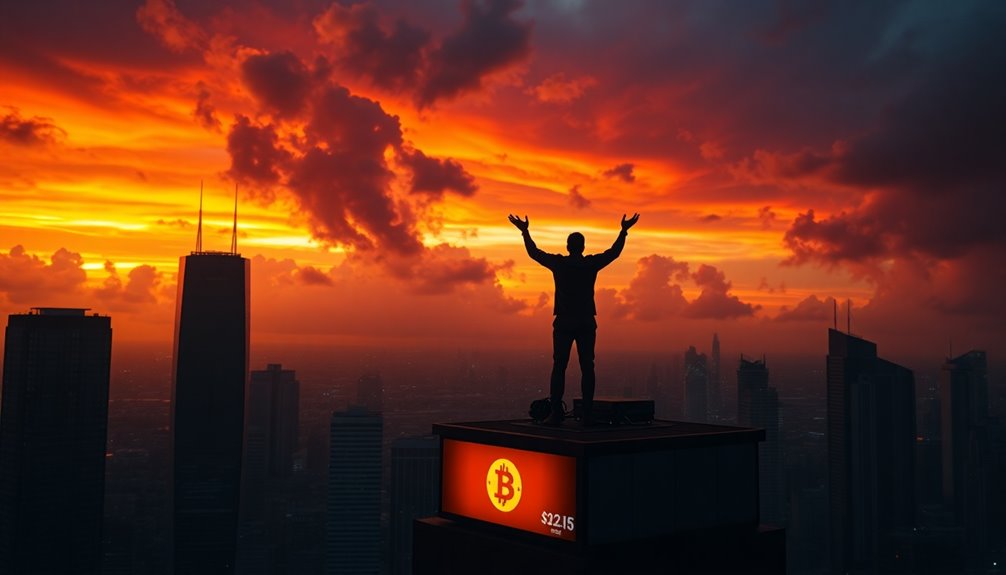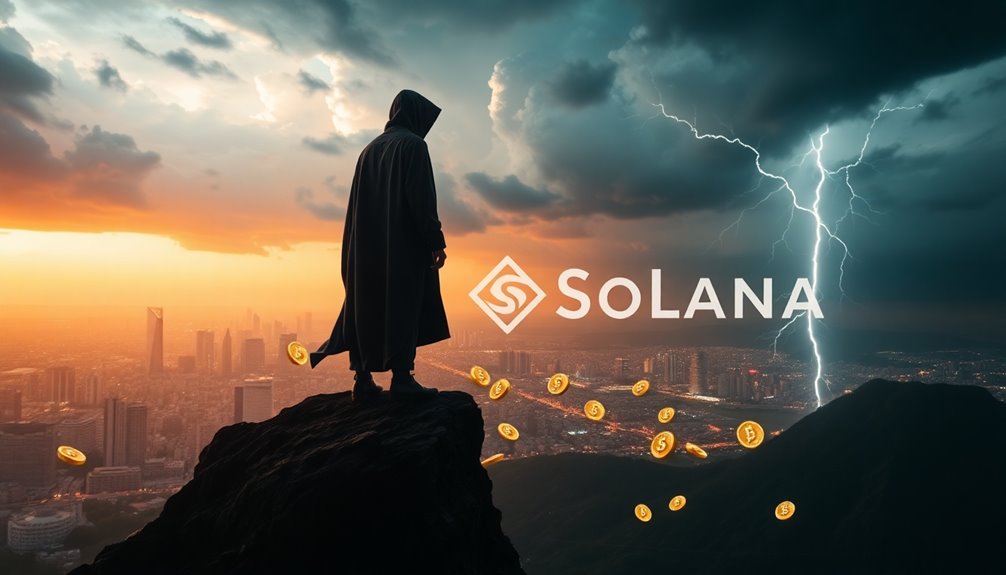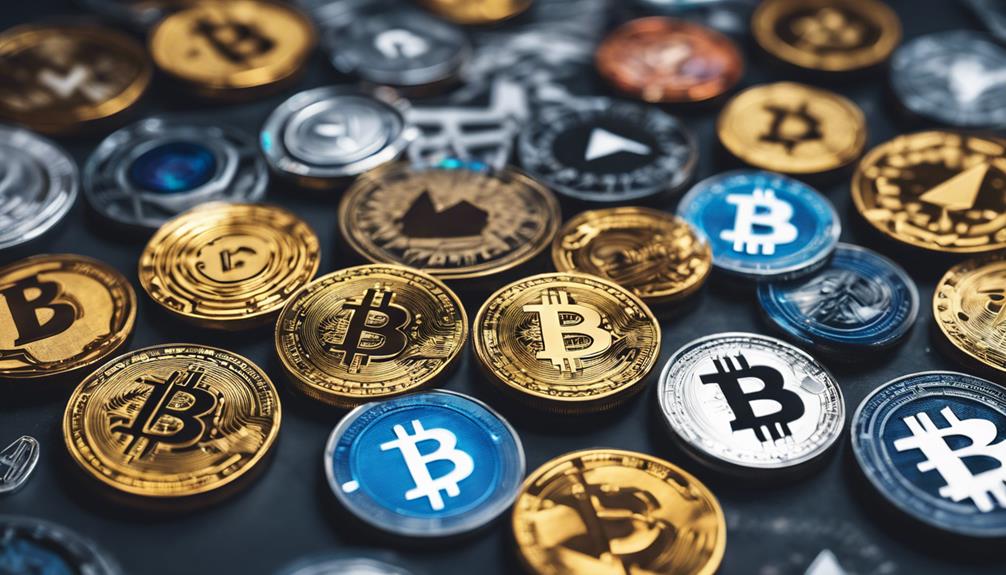While Solana's recent growth is impressive, its golden era might be at risk. Despite achieving high transaction speeds and a surge in active users, structural issues like network outages and centralization threaten reliability. These challenges could diminish user trust and impact the token's value. Technological limitations and scalability concerns also loom large, hindering future development. Additionally, the volatile crypto market adds another layer of uncertainty, potentially destabilizing Solana's gains. It is crucial to weigh these factors carefully, as they could influence the future trajectory of Solana. What's next for Solana could surprise you.
Key Takeaways
- Solana's impressive recent metrics, including high transaction volume and active addresses, may mask underlying reliability and governance issues.
- Frequent outages and centralization concerns have eroded user trust, posing risks to Solana's long-term sustainability.
- Scalability challenges persist despite high throughput, raising questions about Solana's ability to handle increasing demand effectively.
- Market volatility and economic factors can impact Solana's token value, especially during broader cryptocurrency downturns.
- Comparing Solana to Ethereum reveals stability advantages for Ethereum, suggesting potential risks for Solana's future growth trajectory.
Current Performance of Solana

How well is Solana performing right now? The network is showcasing impressive reliability, with a remarkable 309 days of uninterrupted service between February 25, 2023, and December 31, 2023. This marks the longest stretch without a network interruption, indicating a commitment to user trust.
When outages occur, they're quickly resolved, emphasizing Solana's goal of consistent availability.
In terms of transaction throughput, Solana's benchmark stands at 65,000 transactions per second. Although actual transactions per second can vary due to complexity and demand, the network frequently operates below its capacity, thanks to efficient parallel processing designed for large-scale decentralized applications (dApps).
User engagement is thriving, with October 2024 recording a staggering 123 million monthly active addresses—a 42% increase from the previous month. This surge is fueled by the trading of meme coins and active platforms like Pump.fun and Raydium, which saw impressive metrics, including over $30 billion in trading volume.
On-chain transaction volume reached an all-time high of $318 billion, showcasing significant activity, primarily driven by automated transactions.
Solana's current performance signals a robust ecosystem, but can it sustain this momentum?
Structural Challenges Ahead

Structural challenges loom for Solana as it endeavors to maintain its impressive performance amidst growing scrutiny. You might be concerned about network reliability and security, especially given the outages and disruptions Solana has faced. An overwhelming flood of transactions in September 2021 revealed vulnerabilities, and recent congestion has led to a staggering 70% failure rate for non-voting transactions. Furthermore, Solana's high transaction throughput has attracted significant attention, but it also intensifies the pressure on its infrastructure.
Additionally, the degree of centralization raises eyebrows. With high-performance capabilities requiring advanced hardware, fewer participants control a concentration of nodes. Balancing decentralization and effective governance is essential but remains a considerable challenge.
On top of that, regulatory risks threaten adoption and growth. Potential changes in regulations could impact Solana's standing, particularly regarding ETF approvals.
Here's a quick overview of these structural challenges:
| Challenge | Impact |
|---|---|
| Network Reliability | Outages and high transaction failure rates |
| Centralization | Concentration of nodes raises concerns |
| Governance | Evolving leadership affects network direction |
| Regulatory Risks | Uncertainty may hinder adoption and growth |
You need to keep these challenges in mind as they could considerably influence Solana's future trajectory.
Technological Limitations

As Solana navigates its structural challenges, it also grapples with significant technological limitations that could impact its future. These issues not only affect user experience but also hinder the network's overall efficiency. Here's what you should know:
- Network Congestion: High demand periods can lead to slower transaction processing times and increased fees, with some days seeing failure rates over 80%.
- Smart Contract Vulnerabilities: Coding errors can introduce bugs, potentially leading to security breaches and financial losses for users. Solana smart contracts are particularly susceptible to these vulnerabilities due to the complexity of their development.
- Transaction Processing Limits: Each transaction has strict compute unit limitations, which can prevent successful execution and result in wasted fees.
- Regulatory Uncertainty: The evolving regulatory landscape poses risks for smart contracts, affecting their long-term viability and adoption.
- Development Barriers: The use of Rust programming language creates challenges for developers compared to more accessible languages like Solidity, impacting the growth of the ecosystem.
These technological limitations paint a concerning picture for Solana's future, as they may hinder its ability to maintain its status in the competitive crypto landscape.
Market Predictions and Risks

Solana's market predictions and risks present a complex landscape for investors and developers alike. The cryptocurrency market is notoriously volatile, with prices experiencing dramatic swings. A broader downturn could negatively impact Solana's price, especially amid global economic uncertainty that weighs heavily on market stability.
Recent fluctuations, including a 48% surge within a month, underscore this volatility, reminding you of Solana's historical high of $268 in November 2021. This rapid ascent is partly attributed to its ability to process up to 65,000 transactions per second while maintaining low fees. Additionally, the platform's reliance on specialized hardware for optimal performance could pose challenges as mining efficiency evolves. The energy consumption of Bitcoin mining highlights the growing importance of sustainable practices in the cryptocurrency sector. Furthermore, the decentralized nature of blockchain technology can enhance security and transparency, which is vital for investor confidence.
Competition is another risk; Solana faces stiff challenges from established players like Ethereum, Cardano, and Avalanche. Upgrades like ETH 2.0 may further diminish Solana's appeal, making it essential for the platform to showcase innovation and maintain its competitive edge.
Regulatory risks loom large as well, with governments worldwide contemplating rules that could shake investor confidence and add to market instability.
Lastly, network stability is fundamental. Solana has experienced outages in the past, and ensuring a reliable network is crucial for maintaining trust. Such outages can raise concerns similar to those seen in the broader context of digital payments, where technology dependence creates vulnerabilities.
While developer interest is on the rise, any technical hiccup could deter potential projects, making it imperative for Solana to navigate these risks effectively.
Comparing Ethereum and Solana

When comparing Ethereum and Solana, a clear distinction emerges in their transaction capabilities and overall efficiency. Solana stands out with its impressive processing speed, while Ethereum has a more mature ecosystem.
Here are some key differences:
- Transaction Speed: Solana can handle over 2,600 transactions per second (TPS), with a theoretical peak of 65,000 TPS, while Ethereum currently processes around 15 TPS.
- Consensus Mechanisms: Solana uses a hybrid Proof of History (PoH) and Proof of Stake (PoS) approach, whereas Ethereum recently shifted to PoS from Proof of Work (PoW).
- Transaction Fees: Solana's fees are typically less than a cent, making it attractive for users, while Ethereum's fees can spike to $10-$50 during peak times.
- Ecosystem Maturity: Ethereum has a more established ecosystem with greater stability and more decentralized applications (dApps) compared to Solana's growing but smaller network.
- Reliability: Solana has faced network outages, raising concerns about its reliability, whereas Ethereum's long-standing presence bolsters its reputation. Additionally, Ethereum's extensive developer community contributes to its continued innovation and support in the blockchain space.
These factors highlight significant differences that potential users and developers should consider when choosing between the two platforms.
Institutional Interest in Solana

Interest from institutional investors in Solana has surged markedly in recent months, highlighting the platform's potential amidst a rapidly evolving crypto landscape. In Q3 2024 alone, Solana-based applications attracted $173 million in funding, marking a 54% increase from the previous quarter. This influx is the highest since mid-2022, showcasing institutional confidence despite a backdrop of declining funding rounds.
The rise in fee-paying users is equally impressive, with 1.9 million users, a staggering 109% increase quarter-over-quarter. Major financial institutions are recognizing Solana's ability to handle complex transactions efficiently and cost-effectively, thanks to its unique proof-of-history mechanism. Furthermore, the recent funding surge indicates a strong belief in Solana's future growth prospects among investors.
Here's a snapshot of the recent developments in institutional interest:
| Metric | Value |
|---|---|
| Institutional Funding (Q3 2024) | $173 million |
| dApps Raised | 29 |
| Fee-Paying Users | 1.9 million |
| Average Transaction Fee | $0.023 |
As these trends unfold, the landscape for Solana continues to evolve, drawing significant attention from those within the financial sector.
Future Outlook for Solana

Looking ahead, Solana is poised for significant growth, driven by its ambitious technological upgrades and a strong focus on scalability. You can expect the network to enhance its transaction capabilities, aiming for seamless operations as it implements sharding and introduces Token-22 for improved functionality.
Here's what you can look forward to:
- Increased Transactions: Currently handling over 50,000 transactions per second, Solana aims to further boost this capacity, leveraging automation's role in streamlining processes. Additionally, investing in portfolio diversification may help mitigate risks associated with the volatility of the crypto market.
- Enhanced Security: With more rigorous security protocols and cutting-edge cryptographic techniques, your assets will be better protected. Furthermore, the implementation of third-party audits will help ensure platform integrity.
- Robust Ecosystem: Over 3,000 projects are already hosted on Solana, indicating strong adoption and a thriving ecosystem.
- Interoperability: Solana is working towards seamless asset transfers across blockchains, enhancing liquidity and collaboration.
- Positive Price Predictions: Analysts suggest SOL could reach between $250-$300 by the end of 2024, with long-term forecasts soaring even higher.
As these developments unfold, you'll want to keep an eye on how they contribute to Solana's overall stability and growth trajectory in the ever-evolving crypto landscape.
The End of the Golden Era?

As you consider the potential end of Solana's golden era, keep an eye on the increasing market volatility and the technological limitations looming ahead. These factors could challenge Solana's ability to maintain its competitive edge and attract investor confidence. If the network's instability continues and competition intensifies, the path forward might become much more uncertain. Moreover, the emergence of Lunex Network's innovative features may further erode Solana's market position as investors seek more reliable alternatives.
Market Volatility Risks
Market volatility risks loom large over Solana's future, threatening to shake up its established position in the crypto landscape. As an investor, you need to be aware of how unpredictable market conditions can impact Solana's price. Here are some key factors to reflect upon:
- Crypto market volatility often leads to dramatic price swings.
- Broader market downturns can negatively affect Solana's value.
- Global economic conditions can exacerbate price fluctuations.
- Investor sentiment can shift rapidly, impacting Solana's worth.
- Historical data reveals significant price drops during downturns.
With increasing competition from players like Ethereum and Cardano, Solana faces additional pressures that could undermine its appeal. Moreover, as Ethereum's long-term strategy unfolds, it intensifies the competitive landscape and raises questions about Solana's sustainability. Additionally, the environmental consequences of traditional energy sources can lead to market shifts as investors become more conscious of sustainable practices. As many entrepreneurs emphasize the importance of networking, forging strong connections within the crypto community can be crucial for staying informed and resilient amid these challenges. Understanding IRA Investment Strategy can provide insights into how different investment vehicles react to market volatility.
As Ethereum rolls out upgrades, new blockchain systems like Lunex Network are capturing attention, making it vital for you to monitor investor interest.
Additionally, regulatory uncertainty adds another layer of risk; unclear regulations could deter new investments and lead to sudden price movements.
In this volatile environment, maintaining a keen eye on both market trends and competitive dynamics will be essential for safeguarding your investments in Solana.
Technological Limitations Ahead
With market volatility risks still fresh in mind, it's important to scrutinize Solana's technological limitations that could signal the end of its 'Golden Era.' The platform, while renowned for its speed and low fees, has become a double-edged sword due to its complexity and reliance on a niche programming language, Rust. This intricacy makes it tough for newcomers to navigate, limiting developer adoption compared to more popular languages like JavaScript.
Moreover, Solana's network reliability is a growing concern. Recent outages, sparked by high compute transactions and bugs, disrupt user experiences and can lead to financial losses. Even with a previous record of over 300 days without issues, these disruptions raise red flags for investors. Additionally, the platform's ability to achieve thousands of transactions per second is overshadowed by these reliability concerns.
As scalability issues persist, the upcoming Firedancer upgrade might help, but reliance on a few large nodes raises centralization worries. If these technological limitations aren't addressed, Solana's 'Golden Era' may be more fragile than it seems.
Frequently Asked Questions
What Causes Solana's Annual Inflation Rate to Be 5.21%?
Solana's annual inflation rate is currently around 5.21% due to its designed economic model.
It started at 8% and decreases by 15% each year until it hits a target of 1.5%.
This inflation allows for the issuance of new SOL tokens as rewards for validators, promoting network security and transaction validation.
If demand doesn't keep pace with the increasing supply, you might see downward pressure on SOL's price.
How Does Solana's Transaction Fee Structure Impact User Adoption?
Solana's transaction fee structure greatly boosts user adoption. With fees as low as $0.0012, you'll find it affordable to transact.
The network's ability to handle over 65,000 transactions per second means you can engage without delays.
Plus, the burning of 50% of fees reduces supply, potentially supporting the value of SOL.
This combination of cost efficiency, high speed, and sustainability makes Solana an attractive option for users like you.
What Role Do Developers Play in Solana's Ecosystem Growth?
Developers play a vital role in Solana's ecosystem growth by leveraging their expertise in Web3 frameworks and smart contract development.
They create decentralized applications (dApps) and DeFi platforms that drive user engagement and increase total value locked.
With over 2500 active developers, their resilience during market fluctuations showcases commitment.
You'll find that their contributions not only enhance scalability and security but also foster a thriving community, attracting new users and investors alike.
How Can Solana Improve Its Scalability Challenges Moving Forward?
To improve scalability challenges, you can focus on optimizing transaction scheduling and implementing priority fees.
By adopting a new transaction scheduler, you'll enhance block efficiency and processing times. Encouraging developers to refine compute unit requests will also help reduce congestion.
Furthermore, leveraging Proof of History can accelerate transactions during high usage periods. Continuous monitoring and adjustments to the network's performance will guarantee it can handle increasing transaction volumes effectively.
What Are the Potential Implications of Solana ETFS on Market Perception?
Imagine a world where Solana ETFs reshape market perception.
If approved, you'd see enhanced liquidity and skyrocketing interest from institutional investors, boosting Solana's profile. Conversely, rejection could send shockwaves, dampening enthusiasm and signaling setbacks.
As Solana's appeal grows, so does the potential for volatility, but increased institutional involvement could stabilize the landscape.
Ultimately, the fate of Solana ETFs might determine whether you're witnessing a new era or a fleeting moment in crypto history.
Conclusion
As you navigate the turbulent waters of Solana's future, it's clear that the stakes couldn't be higher. With structural challenges and technological limitations looming like dark clouds, the golden era could flicker out faster than a candle in a hurricane. While institutional interest offers a glimmer of hope, the path ahead is fraught with risks. Keep a close eye on market trends; Solana's fate might just hang in the balance, teetering on the edge of a fiery collapse.










